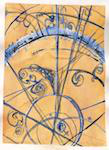Description
Matteo Rinaldi, Daria Savrina
We discuss the computation of the 1->2 splitting functions and matching coefficients at two loops, which are required for the computation of DPS cross sections at NLO.
The contributions to the Double Parton Scattering cross section, due to pairs of interacting partons generated by perturbative splitting is enhanced at short relative transverse distances, between the centers of mass of the two partonic collisions. One my thus foresee the interesting possibility of discriminating experimentally between contributions to the double parton scattering cross...
Double parton scatterings (DPS) provide vital information on the parton-parton correlations and parton distributions in a hadron. DPS also constitutes as a background to new physics searches. The measurement of DPS in Vector Boson (V) + jets processes is important because of clean experimental signature and large production cross-section. The available DPS measurements, with V + jets, are...
We will present an estimate of the effective cross-section in double parton scattering based on the eikonal minijet model with soft gluon resummation, which was recently applied to the calculation of the total and inelastic non-diffractive proton proton cross-section at LHC and to the estimate of survival probabilities at LHC. Comparison with results from an empirical model modified to take...
Though already thirty years have passed since the double parton scattering (DPS) effects have been observed for the first time, a strong interest to this topic still persists. In spite of large theoretical and experimental progress, a lot of space is left for improvement of our understanding of the DPS mechanisms. Certain advantages are provided by studies performed in various final states, in...
Practical solutions to the evolution equations for double-parton distributions (DPDs) that are accurate but feasible in terms of computing resources are a challenging task in the study of double-parton scattering phenomenology in perturbative QCD. Due to the higher dimensionality of DPDs with respect to single PDFs, a simple extension of the available methods for PDF evolution is...
We consider soft gluon evolution of a system of clusters forming the initial state of the cluster hadronziation model, in order to constrain colour reconnection models from a perturbative point of view.
We show that this ansatz produces clusters with properties attributed to
a colour pre-confined state and find strong evidence for formerly investigated colour reconnection models based on...
Double parton distributions (DPDs) are not only an essential building block
needed in factorization theorems to calculate double parton scattering (DPS)
cross sections in perturbation theory, but they also contain very detailed
information about hadronic structure. However, as presently an extraction of
DPDs from experimental data or lattice calculations is not yet feasible, it is
common...
Double parton distributions (DPDs) are an important piece in the description of double hard interactions. On the lattice we calculate correlation functions of two local quark currents, which can be related to Mellin moments of DPDs. For the first moment we calculate all contributing Wick contractions for the pion, considering several channels corresponding to the quark polarization....
The thirty-year long history of the studies of the double parton scattering (DPS) lead to a large number of measurements in various channels and wide range of the collisions energies. At the LHC era the role of the DPS in the production processes becomes more and more significant as its contribution is expected to increase at higher energies. Estimates of this contribution provide an important...
During last thirty years presence of the double parton scattering (DPS) in the hadronic collisions has been demonstrated by a large number of experiments. Though the underlying mechanisms are still poorly understood. Studies of the events involving heavy flavour production allow to reach very small transverse momentum regions and to test the factorization approach to the DPS description with...
We discuss double parton distribution functions (dPDFs), the main non perturbative ingredients appearing in the double parton scattering cross section (DPS) formula in hadronic collisions. By using recent calculations of dPDFs within Light-Front constituent quark models [1], we investigate the role of correlations induced by relativistic effects on dPDF evaluations [2]. Such distributions...
In spite of the recent progress in both theoretical and experimental studies many aspects of multiple parton interactions (MPI) still require a detail investigation. In particular, double parton scattering (DPS) processes can play a dominant role for some specific kinematic regions of multi-jet production, especially in proton-nucleus (pA) collisions where the total DPS cross section...
